I have been teaching spinning and weaving to children for about the last 4 years. It all started when I decided to get more involved in my community. The local elementary school was starting an enrichment program. This is an all-volunteer effort. Some of the things offered are sports, robotics, gardening, music and of course spinning and weaving. The classes are held during school hours as part of the regular curriculum.
When I started this adventure I had only been spinning and weaving for about three years and I had never taught children before. So I borrowed two table looms and a floor loom from my guild (Del Oro Spinners and Weavers). If anyone in the guild thought I was crazy they kept their thoughts to themselves so as not to discourage me. Instead they offered support in yarn donations and ideas for projects. I made some drop spindles from wooden train wheels and dowels. Armed with an unjustified confidence and a good sense of humor I plunged right in.
I have taught everything from kindergarteners to fourth graders. One of my first classes was teaching nine first graders all by myself. Multitasking and patience took on a whole new meaning. I made cardboard looms and showed them how to warp them. They were required to at least try. Some got it right away, some never quite managed but they all tried. The project was all theirs, from picking the colors, warping the loom and weaving the coaster. Some of the children ran to the box of yarn to pick their colors others stood there looking blankly at the box seemingly afraid to even touch the yarn. But with the encouragement of classmates soon even the most timid had their yarn and were working away. I have never seen children so excited by the knowledge that what they made was theirs in every sense of the word. Some wanted to give their project to their mothers, some to their rabbit and others to their doll. In the end they all had something they proudly showed to everyone they could.
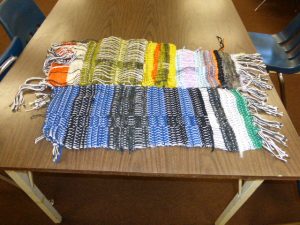
class project
I learned from that experience that five students was the most I can reasonably handle by myself both in fairness to the students and my sanity.
I try to vary the projects. We have spun yarn to make friendship bracelets and did a group project where the students had to work together to make a wall hanging. The children are required to do as much of the project as they can. This involves not only picking the colors but figuring how many warps they need and how long the warps need to be. We talk about shrinkage and loom waste. I briefly go over terminology but I find they remember better if you use the terms in context. Pretty soon the “stick thing” becomes “shuttle” and “strings” become “warp”.
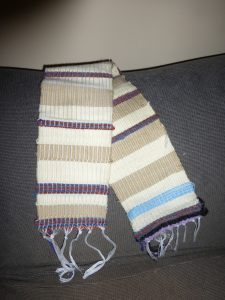
finished project
The drop spindles I made are low whorl. That way the children can set them on the table and spin them like tops virtually eliminating the “drop” part of the activity. I Kool-ade dye the fiber with the students. They love the bright colors.
We have made scarves, purses, gloves, and wall hangings. If there is anything the children want to try to make, we give it a shot.
I currently have one class with four second graders. I have two that are using rigid heddle looms that they warped themselves. Two others are using the table looms. We have also made rope thanks to a rope machine borrowed from Stephanie Gaustad.
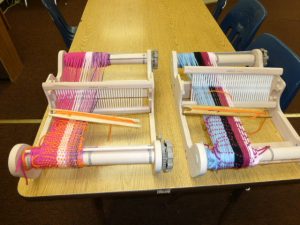
work in progress
The other class I have is nine first grade boys (broken into two groups). We have made rope as a group effort. They are getting better at working together and respecting each other. They love the fact that they get to take home something that they have made.
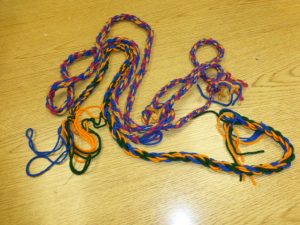
Ropes made in class
Each new class brings new ideas and learning experiences not only for the students but for me as well. The children never miss a class if they can help it which means they need to finish their classwork or they can’t attend weaving. I have been told by many students that mine is their favorite class. It doesn’t get better than that. I have met many people at local events that when I mention I teach the children weaving they say “so you’re the weaving lady.”
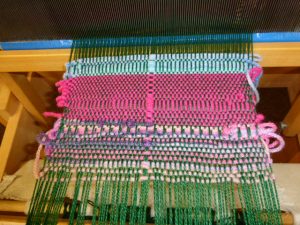
Work in progress
The children always delight me with their enthusiasm and creativity. The great thing about doing spinning and weaving with the younger kids is that it helps make creativity part of their everyday lives. It not only stimulates imagination, it develops team work, hand-eye coordination, requires following instructions, strengthens math skills, and at the end of the day they have something wonderful that they created to take home with them.
CNCH 2016 Conference saw the first ever children’s gallery. I was amazed at the quality and variety these youngsters produces. It made me feel good about the next generation of fiber artists.
Teaching a young child about fiber arts requires enthusiasm and patience, lots and lots of patience. But the rewards are endless. It would be great if all of you would share your experiences teaching a child, weaving, spinning etc. I think we could benefit from the perspective of a child.
I have never regretted getting involved.
I was born in Burlington, Iowa and grew up in the suburbs of Los Angeles. After retiring from the aerospace industry nine years ago I moved to the Sierra Foothills and I began experimenting with weaving. Weaving led to spinning. I have been weaving for six and a half years and spinning for about four. Currently I am the President of Del Oro Spinners and Weavers and teach spinning and weaving at Rail Road Flat Elementary School. Lee Bergman, the weaving lady.
Click here for the next article.
.